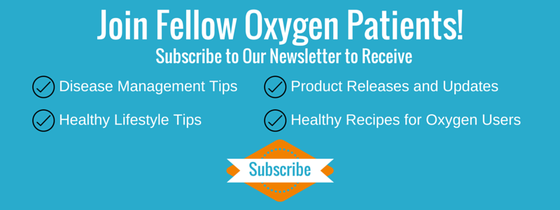Advances in portable oxygen technology have made it increasingly possible for those with cardiopulmonary challenges to lead full and active lives.
People are no longer limited to short car trips or short domestic flights. Those with a need for medical oxygen can go on extended, international flights, cruises, road trips or train rides.
Car/RV Travel
Traveling by car or RV is generally the most convenient way for oxygen patients to travel and the reasons are pretty obvious. You get to travel at your own pace, you can use whichever portable oxygen delivery system you choose, and on top of it all you aren't forced to pay ridiculous prices for mediocre airport food. You also have the luxury of stopping anywhere on your route! Before you set out on your journey check out our top 6 car/RV travel tips for oxygen patients:
- Research Oxygen Suppliers Along Your Route
- Keep their contact information in case of an emergency on your trip
- Keep their contact information in case of an emergency on your trip
- If You're Using a Portable Oxygen Concentrator: Keep Your AC and DC Power Supplies With You
- You will be able to charge and power your concentrator virtually anywhere
- You will be able to charge and power your concentrator virtually anywhere
- If You're Using Oxygen Tanks or Liquid Oxygen: Properly Store and Secure Extra Tanks
- Store them upright, secure them, and check for leaks before setting off on your trip
- Store them upright, secure them, and check for leaks before setting off on your trip
- Keep Emergency Medications and Inhalers Close By
- Make sure you can access your medications and inhalers in case of an emergency
- Make sure you can access your medications and inhalers in case of an emergency
- Keep a Window Cracked
- This keeps airflow moving throughout the car to prevent oxygen from building up in the car (This is extremely important for oxygen tank and liquid oxygen users)
- This keeps airflow moving throughout the car to prevent oxygen from building up in the car (This is extremely important for oxygen tank and liquid oxygen users)
- NO SMOKING
- Absolutely no smoking in the car with your oxygen equipment. This includes other parties in the vehicle. Oxygen is flammable and can cause devastating and fatal injuries
Bus/Train Travel
Although the bus and train travel industries have been overtaken by airline travel, they provide oxygen patients with a reliable and convenient way to travel at a good pace.
Some buses and trains will give you the option to get a seat or a cabin with electrical outlets to make your travel experience that much better. Before you finalize your travel plans, follow these tips to make traveling by bus or train with oxygen as easy as possible!
- Contact Bus/Train Company About Traveling with Oxygen
- Portable oxygen concentrators, liquid oxygen, and oxygen tanks are allowed on buses and trains. However, each bus line and train company will have their own policies and procedures in regards to traveling with oxygen.
- Portable oxygen concentrators, liquid oxygen, and oxygen tanks are allowed on buses and trains. However, each bus line and train company will have their own policies and procedures in regards to traveling with oxygen.
- Obtain Your Prescription for Oxygen
- You will be required to show your prescription and a doctor's note in order to travel, however check with your bus line or train company to ensure you have proper documentation.
- You will be required to show your prescription and a doctor's note in order to travel, however check with your bus line or train company to ensure you have proper documentation.
- If Traveling with a Portable Oxygen Concentrator: Try to Book a Seat/Cabin w/ Power Outlets
- You will be able to plug your unit in and preserve your battery life.
- You will be able to plug your unit in and preserve your battery life.
- If Traveling with Oxygen Tanks/Liquid Oxygen: Pack Your Extra Tanks Accordingly
- Bus lines and train companies may limit how many tanks you can bring with you so plan accordingly.
- Bus lines and train companies may limit how many tanks you can bring with you so plan accordingly.
- Keep Emergency Medications and Inhalers Close By
- Make sure you can access your medications and inhalers in case of an emergency.
- Make sure you can access your medications and inhalers in case of an emergency.
- Plan For Delays/Power Outages
- Make sure you have enough battery life/extra tanks with you to last delays and power outages. Going without your oxygen is not an option.
Cruise Travel
The cruise industry has been welcoming oxygen patients with open arms for years now and cruising is the ultimate relaxing vacation. You are required to provide your own oxygen for the duration of the trip, however, you get to bring your choice of oxygen delivery systems. Make sure you pack your sunscreen and bathing suit! Don't forget to take a look at our top 6 tips for cruising with oxygen below!
- Contact Cruise Liner About Traveling with Oxygen
- Become familiar with their policies and procedures in regards to traveling with oxygen.
- Become familiar with their policies and procedures in regards to traveling with oxygen.
- Obtain Your Prescription and Doctor's Release From
- Most cruise lines are very welcoming of oxygen patients and have become increasingly familiar with your needs. They simply require a copy of your prescription and a doctor's release note stating your condition and approval for travel.
- Most cruise lines are very welcoming of oxygen patients and have become increasingly familiar with your needs. They simply require a copy of your prescription and a doctor's release note stating your condition and approval for travel.
- Give a Minimum of 3 Weeks' Notice That You Are Traveling With Oxygen
- This allows the cruise line to plan accordingly and inform you of their policies and procedures.
- This allows the cruise line to plan accordingly and inform you of their policies and procedures.
- If Traveling with a Portable Oxygen Concentrator: Bring Extra Batteries
- While you will have access to electricity in your room and in different areas throughout the boat extra batteries will prevent you from having to find an outlet or head back to your room for a few hours.
- While you will have access to electricity in your room and in different areas throughout the boat extra batteries will prevent you from having to find an outlet or head back to your room for a few hours.
- If Traveling with Oxygen Tanks/Liquid Oxygen: Overcompensate for Time on the Boat
- You are responsible for providing your own oxygen for the duration of the cruise. With that being said, we recommend you bring as many oxygen tanks as you possibly can. This will cover you in the event that your symptoms flare up, you get delayed disembarking, and anything in-between.
- You are responsible for providing your own oxygen for the duration of the cruise. With that being said, we recommend you bring as many oxygen tanks as you possibly can. This will cover you in the event that your symptoms flare up, you get delayed disembarking, and anything in-between.
- DO NOT PUT ANY OXYGEN EQUIPMENT IN YOUR CHECKED BAGGAGE
- Storing your portable oxygen concentrator, supplemental oxygen tanks, or liquid oxygen cylinders in your checked baggage is strictly prohibited. Request help if you need it when boarding and disembarking the ship.
Airplane Travel
Traveling with oxygen was revolutionized in the early 2000's thanks to the invention of the portable oxygen concentrator. Oxygen tanks and liquid oxygen are prohibited on board commercial airliners for safety reasons. Even if you don't own a portable oxygen concentrator you can always rent one for the duration of your trip. Whether you want to take your dream vacation to Fiji or visit family members in New York, take a look at our top 6 tips for flying with oxygen to make your vacation hassle-free!
- Contact Your Airline and Notify Them You are Traveling with Oxygen
- Every airline has their own policies and procedures in regards to traveling with oxygen.
- Every airline has their own policies and procedures in regards to traveling with oxygen.
- Get a Copy of Your Prescription and Doctor's Note
- A copy of your prescription and doctor's note are required to fly with oxygen. If you do not have the proper documentation, the airline is prohibited from allowing you to board. Some airlines have a pre-made form you can print and have your doctor fill out.
- A copy of your prescription and doctor's note are required to fly with oxygen. If you do not have the proper documentation, the airline is prohibited from allowing you to board. Some airlines have a pre-made form you can print and have your doctor fill out.
- Obtain an FAA Approved Portable Oxygen Concentrator
- For safety reasons liquid oxygen and oxygen tanks are prohibited on board any commercial airliner. In order to fly with oxygen you will be required to purchase or rent an FAA approved portable oxygen concentrator.
- For safety reasons liquid oxygen and oxygen tanks are prohibited on board any commercial airliner. In order to fly with oxygen you will be required to purchase or rent an FAA approved portable oxygen concentrator.
- Make Sure You Have Enough Battery Life
- For all domestic flights the FAA requires you to have 150% of your flight time in battery life. For example, if your flight is 4 hours long you will need to have 6 hours of battery life in order to fly. Most international flights follow the same guidelines, however if you're flying internationally we recommend contacting your airline to see what they require.
- For all domestic flights the FAA requires you to have 150% of your flight time in battery life. For example, if your flight is 4 hours long you will need to have 6 hours of battery life in order to fly. Most international flights follow the same guidelines, however if you're flying internationally we recommend contacting your airline to see what they require.
- Become Familiar with Your Portable Oxygen Concentrator
- Every airline requires that you know how to fully operate your portable oxygen concentrator. In some cases they will request that you show them that you know how to use the unit. If you are unable to operate the concentrator, someone who is flying with you must be able to.
- Every airline requires that you know how to fully operate your portable oxygen concentrator. In some cases they will request that you show them that you know how to use the unit. If you are unable to operate the concentrator, someone who is flying with you must be able to.
- Pre-Charge Your Batteries
- Most portable oxygen concentrator batteries take between 2 and 6 hours to fully charge. Make sure your batteries are fully charged the night before you leave. This will reduce your stress level and allow you to wake up and go.




